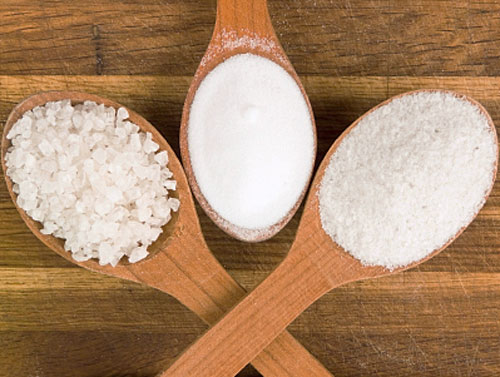
Written By: Gloria Tsang, RD
Title: Founding Registered Dietitian
Alumni: University of British Columbia
Last Updated on:

Salt-rimmed glasses, marinades and rubs, cooking and baking – the uses for salt seem endless, and that’s just within the food and recipe realm of salt. The Salt Institute states that “salt is the most common and readily available nonmetallic mineral in the world,” and in 2008, world salt production amounted to about 260 million tons. With all this salt production and consumption, do we have any idea how the different salt types compare in their physical characteristics, uses, and sodium content?

Table of Contents
Table salt consists of cube-shaped crystals that give it its uniform, square cube shape and its ability to dissolve uniformly in your mouth. Table salt crystals are smaller than those of kosher salt, and table salt contains additives to keep these small crystals from caking and clumping. Table salt is usually iodized, but uniodized varieties are also available. Iodized salt is salt which has been fortified with the essential trace mineral iodine.
Table salt is an all-purpose, easily stored, granulated salt and its use extends from general baking, cooking, canning, and pickling to the table alongside its pepper shaker mate.
Kosher salt is made similarly to table salt, but differs in its texture and shape. Kosher salt is made up of larger crystals than table salt and has a distinct, coarse texture that is ideal for crumbling between fingertips for uniform and controlled seasoning of food. Kosher salt is certified as kosher by one of many rabbinical inspection institutions, and kosher salt is additive-free.
Kosher salt has gained popularity in mainstream cooking and is not just limited to gourmet recipes. The coarse kosher salt offers a welcome flaky texture and flavorful twist for precise food seasoning.
Sea salt is produced by the evaporation of sea water due to atmospheric temperature and pressure, or, more simply, sea water evaporates in the sun and wind, leaving the salt behind. A sea salt “crop” may take many months or years to grow before harvesting and for this reason sea salt is most often more expensive than kosher or table salt. Sea salt is available in either coarse or fine varieties.
The purity of sea salt adds a gourmet flavor to many dishes.
“Light” or “half” salt products contain approximately 50% less sodium than regular table salt, while still providing much the same texture and cooking results as regular table salt.
Light and half salts may replace table salt for everyday use.
Whether you prepare your own rubs and marinates or bake from scratch, enjoy the variety of salt types at your fingertips while having the ability to control the sodium content of your foods. Kosher and sea salt are both lower in sodium than table salt. For those requiring sodium-restricted diets, use herbs, spices, or other natural flavorings.
Alumni: University of British Columbia – Gloria Tsang is the author of 6 books and the founder of HealthCastle.com, the largest online nutrition network run by registered dietitians. Her work has appeared in major national publications, and she is a regularly featured nutrition expert for media outlets across the country. The Huffington Post named her one of its Top 20 Nutrition Experts on Twitter. Gloria’s articles have appeared on various media such as Reuters, NBC & ABC affiliates, The Chicago Sun-Times, Reader’s Digest Canada, iVillage and USA Today.
What is Glycemic Index (GI)? Does It Help Weight Loss? Diabetes?